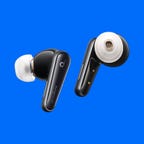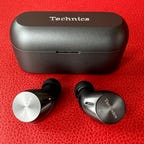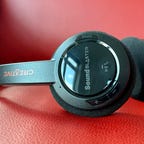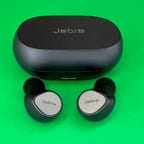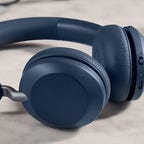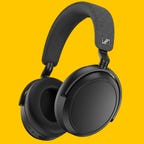
Best Sennheiser noise-canceling headphones
Sennheiser Momentum 4 Wireless
View details
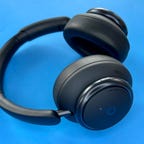
Premium noise-canceling headphones for less
Soundcore by Anker Space Q45
View details

Instantly earn an Amazon gift card upon approval, plus rewards and protections for your Amazon purchases.
5% cash back
on Amazon and Whole Foods purchases
Rewards
redeemable to cover Amazon purchases or at Chase.com for cash back, gift cards, or travel.
Up to 120 Days
of protection against damages or theft on new purchases.
Did you know that headphones with Bluetooth 5.0 standard and above can allow you to connect multiple devices to them simultaneously? For example, you can choose to connect your headphones to your laptop and phone (or if you’re a gamer, your Steam Deck and phone), and it will switch the audio between them when one is active. This offers a significant amount of flexibility and variety in the types of accessories you can use at once — from Bluetooth speakers and wireless headphones to wireless mice and keyboards. That is, provided that the manufacturer implements this feature into the device.
Read more: Best Tech Gifts Under $100
When it comes to Bluetooth earbuds and headphones, it’s beneficial to be able to pair to multiple devices at the same time, meaning you don’t have to manually connect and disconnect every time you start using a different device. For instance, if you’re watching a YouTube video on your laptop and decide you’d actually fancy listening to some music on Spotify from your phone, your multipoint headphones can seamlessly pause one audio source and move to the other.
Alternatively, if you’re someone who is on the go and works from home and you’re getting a call, your multipoint headphones can pause a podcast. This allows you to hear the ringtone and the caller’s voice and then, after the conversation, the headphones will resume the original audio source.
Jonathan Levine, CEO and founder of Master & Dynamic recently spoke about the potential and useability of multipoint use in headphones. “Up until recently, Bluetooth chips supported a maximum of two simultaneous connections. This makes multipoint easy for headphones, where a wire connects both ear cups. For a true wireless product, one of the two connections gets consumed by the other earphone — leaving only one available connection to an audio source. Cutting-edge connectivity protocols have allowed true wireless products to connect much more seamlessly and bypass the maximum limit of two connections.”
In 2024, multipoint headphones have become quite common, indicating the feature is no longer limited to premium models or business headsets, even budget earbuds are now equipped for the job. Multipoint pairing isn’t in every pair of headphones, and its implementation can come with limitations depending on the manufacturer.
Both Apple and Samsung have a variation of multipoint Bluetooth pairing called “automatic switching,” which works only for devices in their respective ecosystems. For instance, your AirPods Pro 2 can connect to your iPhone and Mac simultaneously (and an iPad) but a non-Apple device can’t participate. Samsung’s various Galaxy Buds also work similarly with Galaxy smartphones and tablets.
The consumer headphones in this list are platform agnostic, meaning they aren’t limited to multipoint pairing with a single manufacturer, and they were hand-tested by CNET’s expert reporters and gadget reviewers. We also have a separate guide to the best headphones for working from home, which includes some of the more business-class headsets with boom mics and USB dongles for reliable wireless PC connectivity – but for anyone after the best multipoint Bluetooth headphones and earbuds in 2024, we have the very best for you below.
The QuietComfort 45 has virtually the same design as its predecessor, the QuietComfort QC35 II, which many people consider one of the most comfortable over-ear headphones, if not the most comfortable. It has the same drivers, according to Bose, and the buttons are in the same place. There are small but notable changes. First off, these have USB-C instead of micro-USB.
Secondly, the microphone configuration is different. Not only have the mics been shifted on the headphones, but there’s now an extra external microphone for voice pick-up, which means the QC45 has a total of six microphones, four of which are beamforming and used for voice. By contrast, the QC35 II has a total of four, two of which are used for voice. (The Bose Noise Canceling Headphones 700 also have six microphones total.)
These headphones are excellent for making calls. They’re similar to the Bose Headphones 700 in that regard. They also include top-notch noise canceling and multipoint Bluetooth pairing, so you can connect them with a PC and your phone simultaneously. Read our full review of the QuietComfort 45.
When you have a product that a lot of people love, change can be risky. Such is the case for Sony’s WH-1000XM5, the fifth generation of the 1000X series headphones, which were first released in 2016 as the MDR-1000X Wireless and have become increasingly popular as they’ve improved with each generation. Over the years, Sony has made some tweaks to the design, but nothing as dramatic as what it’s done with the WH-1000XM5. Other than the higher $400 price tag, most of those changes are good, and Sony’s made some dramatic improvements with voice-calling performance as well as even better noise canceling and more refined sound.
Note that you do have to activate multipoint pairing in the Sony Headphones companion app for the feature to work.
No earbuds are perfect, and not everybody will love the fit of the Sony WF-1000XM4 buds. If you’re looking for earbuds with quality sound, active noise cancellation, solid voice-calling capabilities and good battery life, these buds check all the boxes. They are frequently on sale, as Sony is expected to release next-gen flagship earbuds later this year.
Like the Linkbuds and Linkbuds S, these buds initially didn’t have multipoint Bluetooth pairing but Sony added the feature late last year. It does have to be activated in the companion Sony Headphones app to work.
Their sound isn’t quite up to the level of higher-end buds like Apple’s AirPods Pro 2 and the Sennheiser Momentum True Wireless 3 which cost significantly more, but the Soundcore by Anker Liberty 4 earbuds have a strong set of features, including a spatial audio mode with head tracking, multipoint Bluetooth pairing, up to nine hours of battery life, wireless charging and support for Sony’s LDAC audio codec that can offer sound improvements if you have the right setup.
Compared to top-sounding buds I’ve reviewed, they lack a bit of overall clarity, accuracy and bass definition. Most people will think they sound quite good. They play plenty loud and deliver strong bass, and you can tweak their sound profile in the app or create a personal HearID Sound profile (it’s also for noise canceling).
Unlike the “open” LinkBuds, the LinkBuds S are traditional noise-isolating earbuds with tips that jam in your ears. They’re more compact and lighter than Sony’s flagship WF-1000XM4 and also feature Sony’s V1 processor. Their sound and noise canceling don’t quite measure up to the XM4s, but they’re close and cost less. They’re the Sony buds for people who can deal with larger buds like the XM4 but want 80 to 85% of those buds’ features and performance for $21 less.
Initially, these buds didn’t have multipoint Bluetooth pairing, but Sony added it late in 2022. It does have to be activated in the companion Sony Headphones app.
The Pixel Buds Pro are Google’s first earbuds to feature active noise canceling. While it’s nice that they finally have a feature that a lot of true-wireless earbuds have had for a while, what ultimately sets the Pixel Buds Pro apart and makes them worth considering — particularly for Android users — is their distinct design and winning fit. That helps enhance their performance on both the sound quality and noise-canceling fronts. While not quite elite for voice-calling, they did perform well as a headset for making calls. A couple of features were missing at launch — spatial audio and a five-band equalizer — but the equalizer has now been added with a firmware update. We’re now just waiting for spatial audio with full head tracking.
Note that multipoint has to be enabled for it to work with these buds (read how here).
Read our Google Pixel Buds review.
Sennheiser’s previous-generation Momentum Wireless headphones have always had a pretty distinct look that was part retro, part modern, and stood out for the exposed metal on their headband. For better or worse, that’s all gone now, and the new Momentum 4 Wireless, Sennheiser’s flagship noise-canceling headphones, look a bit more subdued and also a bit more like some of their competitors.
The Momentum 4 Wireless offers superior performance over the Momentum 3 Wireless in every regard, although the biggest gains are with noise canceling and voice-calling performance as well as battery life, which is outstanding — up to 60 hours at moderate volume levels. There’s also a transparency mode that allows ambient sound in, as well as the ability to create a custom sound profile in the Smart Control app for iOS and Android using the built-in EQ, sound modes and a new Sound Personalization feature that “assesses the user’s listening preferences and adjusts the listening experience according to their taste.”
Equipped with 42mm drivers, Sennheiser says the Momentum 4 Wireless offers “best-in-class” sound, which is debatable. I’d say the Momentum 4’s sound quality is right there with other models in this price range. They sound excellent, with the requisite well-defined, punchy bass, relatively wide soundstage (they sound pretty open) and smooth treble that brings out some of the finer details in well-recorded tracks. They’re a pleasure to listen to.
Panasonic’s Technics EAH-AZ60 buds don’t have quite as premium a feel as the earlier EAH-AZ70W, but they sound sweet with clean, well-balanced sound, well-defined bass and good detail. They feature active noise canceling (it’s good), a transparency mode, multipoint Bluetooth pairing (so you can connect to your computer and phone at the same time) and they have very solid voice-calling performance with good noise reduction. The buds are IPX4 splash-proof and are rated for up to seven hours of battery life on a single charge at moderate volume levels.
They’re missing some features usually found at this price point: Notably, an ear-detection sensor that automatically pauses your music when you pull the earbuds out of your ears, and wireless charging (the former feature is more important). The step-down EAH-AZ40 also sounds good but the EAH-AZ60 not only has larger drivers (8mm compared to 6mm) but also supports Sony’s LDAC audio codec and has two additional microphones for voice calling and noise canceling (the EAH-AZ40 doesn’t have noise canceling). The original Technics EAH-AZ60 are currently hard to find new — Amazon only has them used — but you can get the updated EAH-AZ60M2 for $250.
I was a fan of Creative’s original Sound Blaster Jam headphones that came out in 2015 and had a decidedly retro look and feel, with good sound for the money. Now they’re available in a 2.0 version that has some key upgrades, including Bluetooth 5.0, USB-C charging, improved call quality and multipoint Bluetooth pairing that allows you to pair it to two devices simultaneously. Battery life is rated at up to 22 hours.
I was able to pair this wireless headphone set with a Mac Mini and an iPhone 12 Pro and then switch audio between them. Often when pairing Bluetooth headphones with Mac and Windows PCs, one can encounter some issues, but once I got the headphones paired with both my PC and phone, they made a good pair of work-from-home headphones. Also, the price is right for parents looking for a decent set of kids’ headphones for remote learning and everyday use.
Comfortable for on-ear headphones, the Jam V2s are lightweight and have a nicely balanced sound with good detail and bass that’s ample but not overpowering. Call quality was good in my tests with callers saying they could hear me well even on the noisy streets of New York. No carry pouch is included, but you do get an extra set of foam ear pads, which is good because they will wear out over time.
The headphones have physical buttons for controlling volume and playback, and there’s aptX support for devices that support the wireless streaming codec.
The No. 5909 are premium audio brand Mark Levinson’s first headphones. Yes, they’re expensive at $999 and probably a wee bit overpriced, but they’re excellent. They have a sturdy design without managing to feel hefty on your head (read: they’re substantial, but not heavy) and they’re comfortable to wear over long periods thanks to their nicely padded (and replaceable) leather-covered earcups and headbands.
Not only do they have good noise canceling and excellent sound, but their voice-calling performance is top-notch, making them one of the best noise-canceling headphones options on the market. Plus, they have multipoint Bluetooth pairing so you can pair them with two devices, such as a computer and a phone, simultaneously.
The No. 5909 are high-res certified with support for Sony’s LDAC and Qualcomm’s aptX Adaptive codecs that allow for near-lossless streaming over Bluetooth. Apple’s iPhones and iPads don’t support those codecs while certain Android devices do. Using the No. 5909 headphones over Bluetooth on my iPhone 13 Pro, it sounded a tad more natural and refined than the AirPods Max (the No. 5909 had a touch more “pure” and accurate sound).
I did notice a difference when I paired the No. 5909 to my Google Pixel 4 XL, which has support for LDAC, and using the Qobuz audio streaming service that offers high-res streaming. Overall, the sound had a little more depth and texture, and there’s a touch more sparkle, definition and openness.
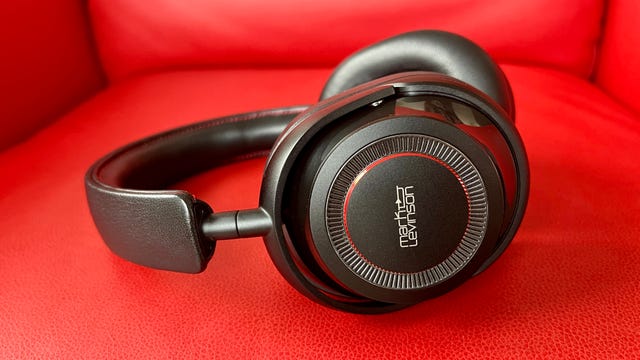
Photo Gallery 1/1
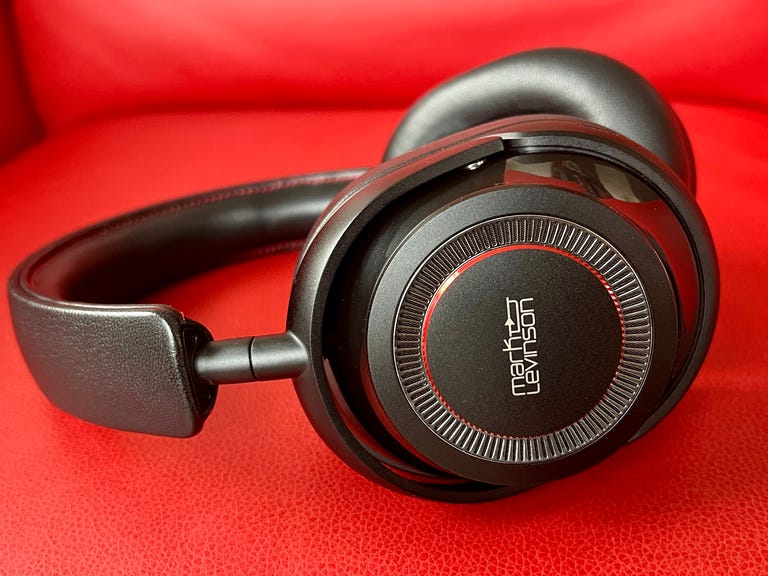
I got the all-black version of the No. 5909. It’s also available with a red or pewter trim.
David Carnoy/CNET
If you can’t afford Sony’s WH-1000XM5 or Bose QC45, the Soundcore by Anker Space Q45 (yes, there’s a bit of copying going on here) is a good alternative for $150, and we should see occasional discounts on it. While it may not fit some smaller heads, it’s comfortable to wear, with nicely padded ear cups and a dual-hinge folding design. Sound quality is very good and the headphones offer better noise canceling than the step-down Q35, as well as multipoint Bluetooth pairing (these are equipped with Bluetooth 5.3) and support for the LDAC audio codec for streaming high-resolution music tracks over Bluetooth, if you have a device that supports LDAC. Many Android phones do, although Samsung’s Galaxy phones don’t.
Battery life is very good at up to 50 hours with noise canceling on at moderate volume levels and the headphones come with a hard carrying case for travel.
AfterShokz has changed its name to Shokz and released new ninth-gen bone-conduction headphones that offer improved bass performance compared to the company’s earlier flagship model, the Aeropex (now called the Shokz OpenRun). That makes the OpenRun Pro the best bone-conduction headphones you can get right now, although they still can’t match the sound quality of traditional headphones.
Bone-conduction wireless headphones don’t go on your ears; they deliver sound through your cheekbones. The big benefit of this technology as a safety feature for running is that thanks to its open design, you can hear what’s going on around you — traffic noise in particular — while listening to music or having a phone conversation. Also, some race coordinators don’t allow runners to wear anything in their ears, which is where headphones like this come in handy.
They do offer fuller sound with more bass, but it’s an incremental improvement, not a huge leap forward. Like other bone-conduction headphones these are strongest in the midrange where voices live so they’re best for podcasts, talk radio, newscasts and audiobooks. They’re also good for making calls and, like other Shokz models, have multipoint Bluetooth pairing.
Shokz also makes other more affordable models as well. The OpenComm, which integrates a boom microphone, also has multipoint Bluetooth pairing.
Coming in at 16% smaller than the Elite 75t, the Elite 7 Pro are Jabra’s top-of-the-line earbuds in its new range and include the company’s new MultiSensor Voice technology with a bone-conduction sensor, four microphones and intelligent algorithms to deliver new “ground-breaking call quality,” Jabra says. The voice calling performance doesn’t quite live up to the hype, but Jabra has updated the buds’ firmware and added multipoint Bluetooth pairing and other small improvements.
These have adjustable active noise cancellation, Jabra’s HearThrough transparency mode and Bluetooth 5.2. They offer up to nine hours’ of play time at moderate volume levels with noise canceling on, and nearly three additional charges in the charging case. The total battery life is rated at 35 hours. The charging case has wireless charging capabilities.
The earbuds’ IP57 rating means they are dust-resistant and fully waterproof (they can be submerged in up to 1 meter of water). For those who like to use only a single bud, you can also use either bud independently in a mono mode.
Released in mid-2020, the Jabra Elite 45h was essentially billed as the best on-ear headphones for the money. There’s nothing fancy about them, but they’re among the best-value on-ear headphones right now. They have good sound quality, a sturdy design and a comfortable fit (for on-ear headphones). They perform well as a headset for making calls too, and include a sidetone feature that allows you to hear your voice so you don’t talk too loudly. Battery life is also good and it has multipoint Bluetooth pairing so you can connect to your computer and your phone at the same time, and easily switch between the two should a call come in on your phone. It mostly works. Although this item is discontinued on its main page, you can still pick up a pair on Amazon for $150.
Note that the currently on sale $169 Evolve2 65, which has an integrated boom microphone, is essentially the souped-up office version of these headphones.
The MW75 is Master & Dynamic’s best full-size headphones yet. Needless to say, they’re pricey at $599; most people will be quite satisfied with the Sony WH-1000XM5 (ranging from $315 to $400), which is lighter and more comfortable, and delivers best-in-class voice calling and noise canceling. The MW75’s build quality is hard to beat and they offer top-notch sound for a wireless model (I thought they sounded better than Apple’s AirPods Max headphones), plus strong voice-calling and noise-canceling performance. With their support for aptX Adaptive, they have additional appeal for Android users, who can get a touch better sound quality with the right setup. I was also quite happy streaming music with my iPhone 13 Pro using the AAC codec.



